BCORL1 is an independent prognostic marker and contributes to cell migration and invasion in human hepatocellular carcinoma
- PMID: 26879601
- PMCID: PMC4754820
- DOI: 10.1186/s12885-016-2154-z
BCORL1 is an independent prognostic marker and contributes to cell migration and invasion in human hepatocellular carcinoma
Retraction in
-
Retraction Note: BCORL1 is an independent prognostic marker and contributes to cell migration and invasion in human hepatocellular carcinoma.BMC Cancer. 2023 Jun 13;23(1):542. doi: 10.1186/s12885-023-11051-6. BMC Cancer. 2023. PMID: 37312101 Free PMC article. No abstract available.
Abstract
Background: The deregulation of E-cadherin has been considered as a leading cause of hepatocellular carcinoma (HCC) metastasis. BCL6 corepressor-like 1 (BCORL1) is a transcriptional corepressor and contributes to the repression of E-cadherin. However, the clinical significance of BCORL1 and its role in the metastasis of HCC remain unknown.
Methods: Differentially expressed BCORL1 between HCC and matched tumor-adjacent tissues, HCC cell lines and normal hepatic cell line were detected by Western blot. The expression of BCORL1 was altered by siRNAs or lentivirus-mediated vectors. Transwell assays were performed to determine HCC cell invasion and migration.
Results: Increased expression of BCORL1 protein was detected in HCC specimens and cell lines. Clinical association analysis showed that BCORL1 protein was expressed at significant higher levels in HCC patients with multiple tumor nodes, venous infiltration and advanced TNM tumor stage. Survival analysis indicated that high expression of BCORL1 protein conferred shorter overall survival (OS) and recurrence-free survival (RFS) of HCC patients. Multivariate Cox regression analysis disclosed that BCORL1 expression was an independent prognostic marker for predicting survival of HCC patients. Our in vitro studies demonstrated that BCORL1 prominently promoted HCC cell migration and invasion. Otherwise, an inverse correlation between BCORL1 and E-cadherin expression was observed in HCC tissues. BCORL1 inversely regulated E-cadherin abundance and subsequently facilitated epithelial-mesenchymal transition (EMT) in HCC cells. Notably, the effect of BCORL1 knockdown on HCC cells was abrogated by E-cadherin silencing.
Conclusions: BCORL1 may be a novel prognostic factor and promotes cell migration and invasion through E-cadherin repression-induced EMT in HCC.
Figures
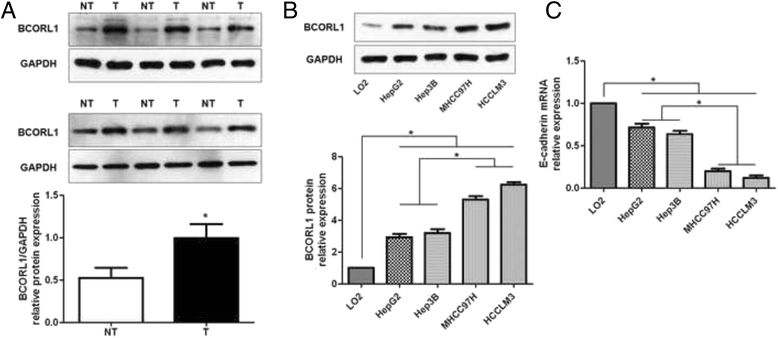
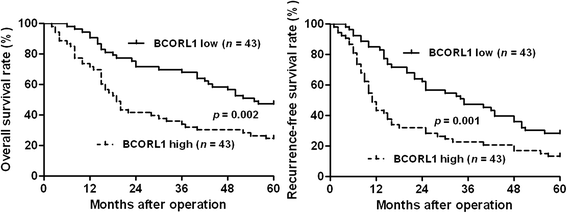

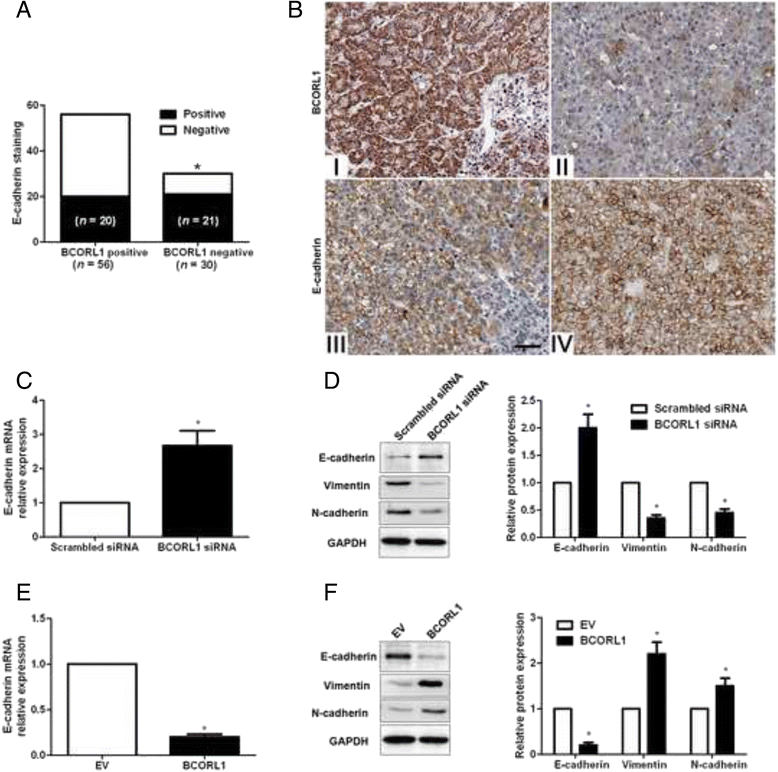
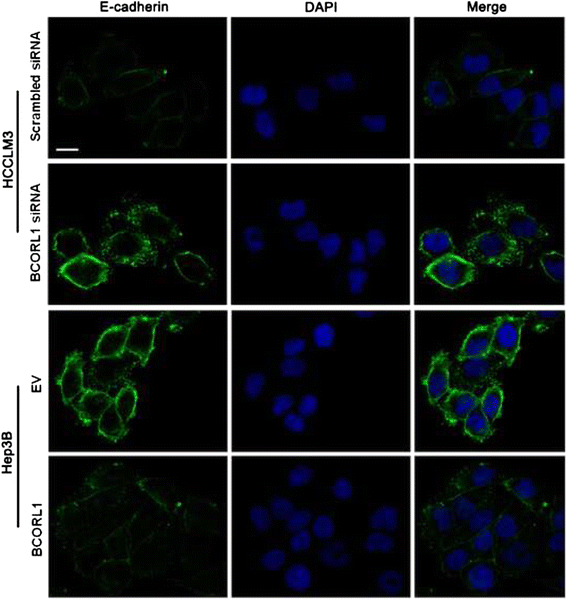
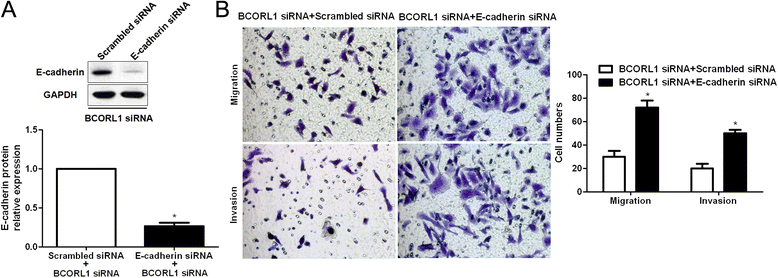
Similar articles
-
MicroRNA-876-5p inhibits epithelial-mesenchymal transition and metastasis of hepatocellular carcinoma by targeting BCL6 corepressor like 1.Biomed Pharmacother. 2018 Jul;103:645-652. doi: 10.1016/j.biopha.2018.04.037. Epub 2018 Apr 24. Biomed Pharmacother. 2018. PMID: 29679906
-
FoxM1 overexpression promotes epithelial-mesenchymal transition and metastasis of hepatocellular carcinoma.World J Gastroenterol. 2015 Jan 7;21(1):196-213. doi: 10.3748/wjg.v21.i1.196. World J Gastroenterol. 2015. PMID: 25574092 Free PMC article.
-
T-box Transcription Factor Tbx3 Contributes to Human Hepatocellular Carcinoma Cell Migration and Invasion by Repressing E-Cadherin Expression.Oncol Res. 2018 Jul 5;26(6):959-966. doi: 10.3727/096504017X15145624664031. Epub 2018 Jan 2. Oncol Res. 2018. PMID: 29295731 Free PMC article.
-
[Expression and clinical significance of BCL6 corepressor-like 1 in non-small cell lung cancer].Xi Bao Yu Fen Zi Mian Yi Xue Za Zhi. 2015 Dec;31(12):1677-81. Xi Bao Yu Fen Zi Mian Yi Xue Za Zhi. 2015. PMID: 26648304 Chinese.
-
Fibulin-5 inhibits hepatocellular carcinoma cell migration and invasion by down-regulating matrix metalloproteinase-7 expression.BMC Cancer. 2014 Dec 12;14:938. doi: 10.1186/1471-2407-14-938. BMC Cancer. 2014. PMID: 25494879 Free PMC article.
Cited by
-
Gene mutation analysis using next-generation sequencing and its clinical significance in patients with myeloid neoplasm: A multi-center study from China.Cancer Med. 2023 Apr;12(8):9332-9350. doi: 10.1002/cam4.5690. Epub 2023 Feb 17. Cancer Med. 2023. PMID: 36799265 Free PMC article.
-
Epigenetic and Immune-Cell Infiltration Changes in the Tumor Microenvironment in Hepatocellular Carcinoma.Front Immunol. 2021 Dec 2;12:793343. doi: 10.3389/fimmu.2021.793343. eCollection 2021. Front Immunol. 2021. PMID: 34925377 Free PMC article.
-
Concomitant BCORL1 and BRAF Mutations in Vemurafenib-Resistant Melanoma Cells.Neoplasia. 2018 May;20(5):467-477. doi: 10.1016/j.neo.2018.02.009. Epub 2018 Mar 30. Neoplasia. 2018. PMID: 29605720 Free PMC article.
-
Case of aggressive metastatic follicular variant papillary thyroid carcinoma with BRAF K601E and BCORL1 mutations.BMJ Case Rep. 2020 Jun 30;13(6):e234208. doi: 10.1136/bcr-2019-234208. BMJ Case Rep. 2020. PMID: 32606114 Free PMC article.
-
Targeted next-generation sequencing of 565 neuro-oncology patients at UCLA: A single-institution experience.Neurooncol Adv. 2020 Jan-Dec;2(1):vdaa009. doi: 10.1093/noajnl/vdaa009. Epub 2020 Jan 29. Neurooncol Adv. 2020. PMID: 32118206 Free PMC article.
References
Publication types
MeSH terms
Substances
LinkOut - more resources
Full Text Sources
Other Literature Sources
Medical

